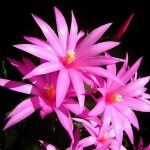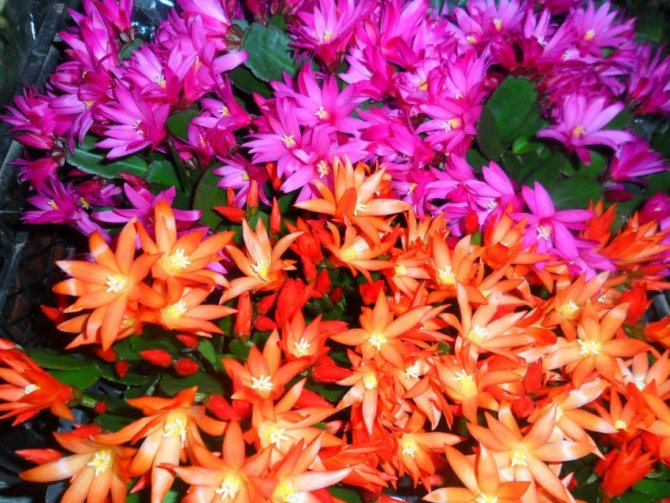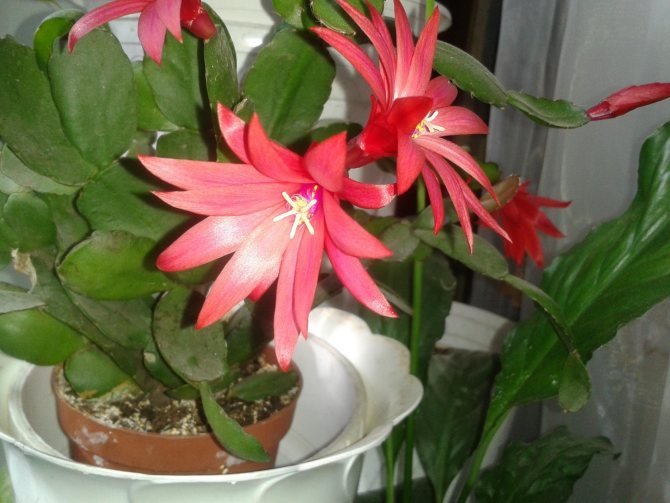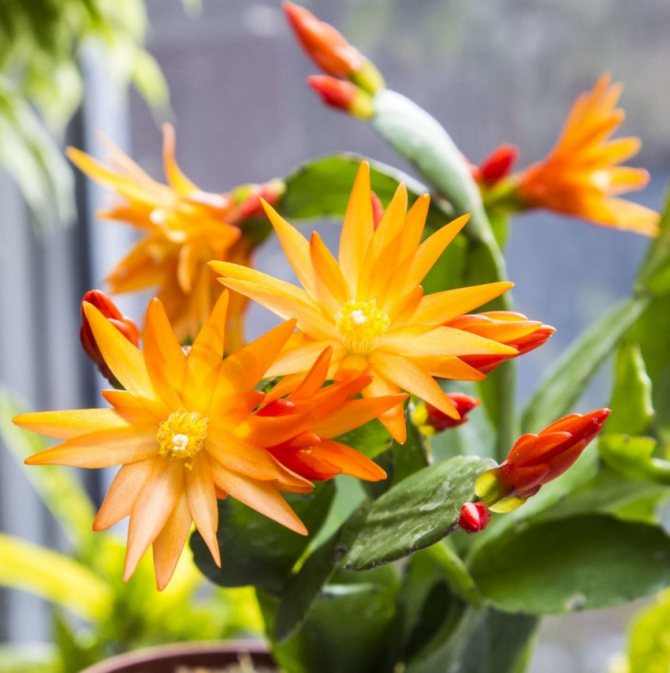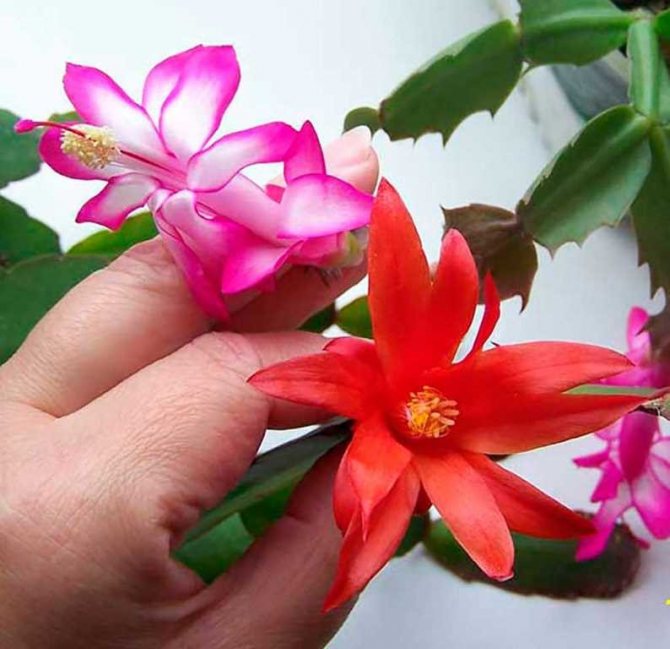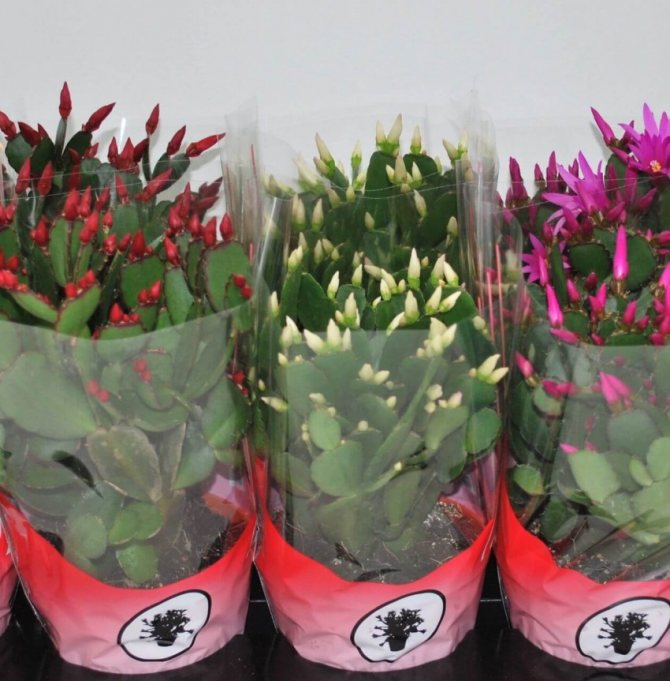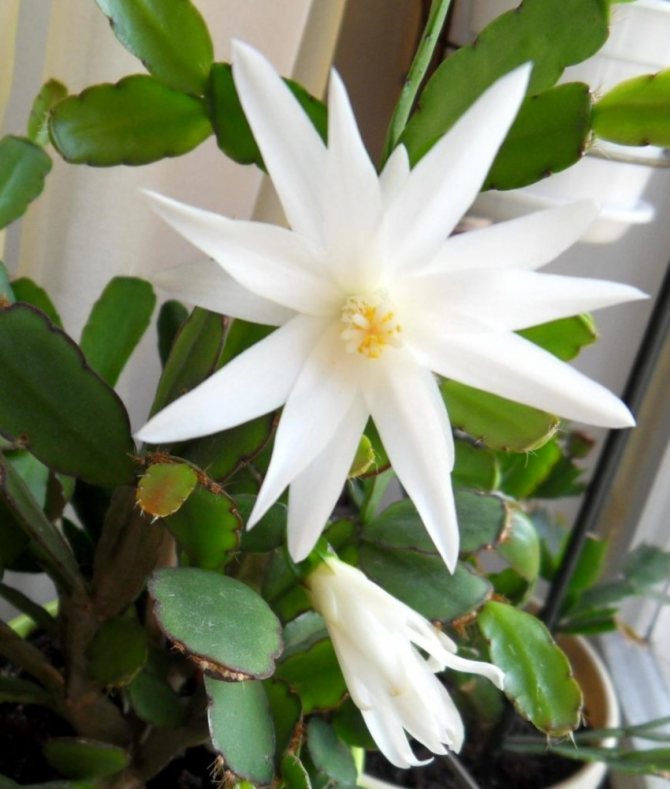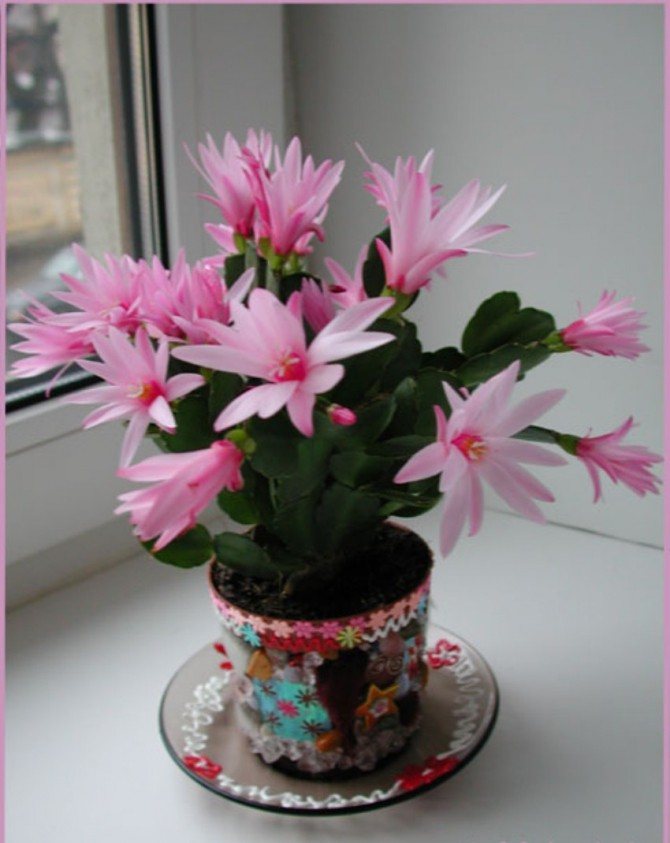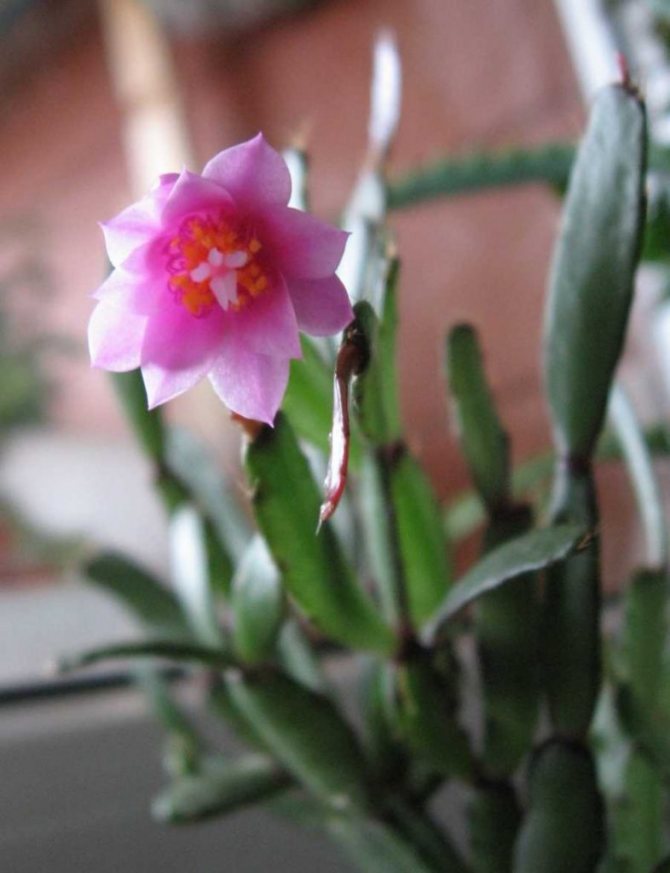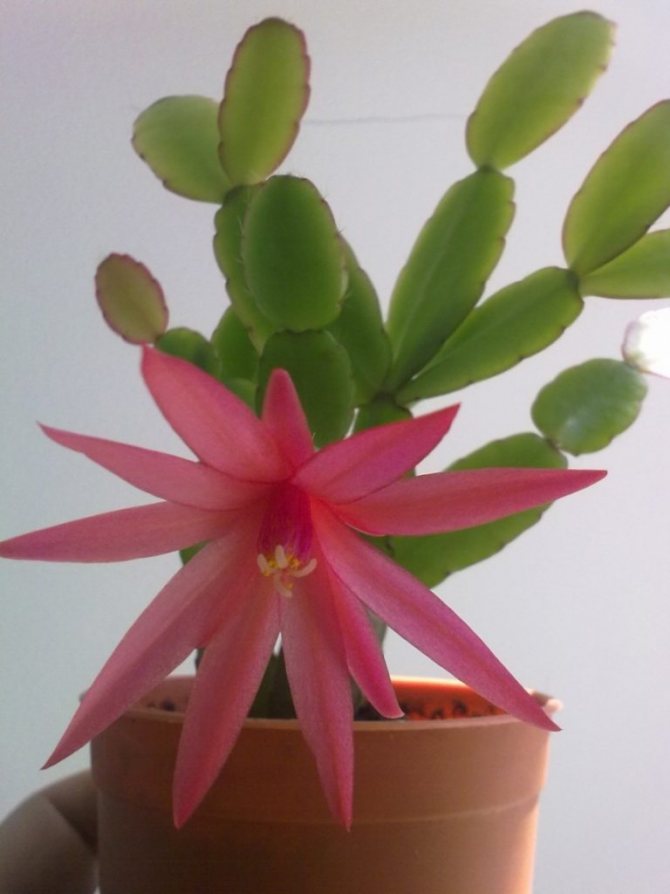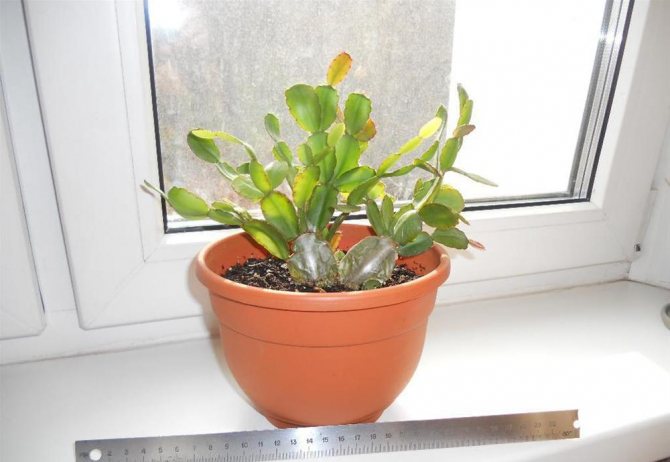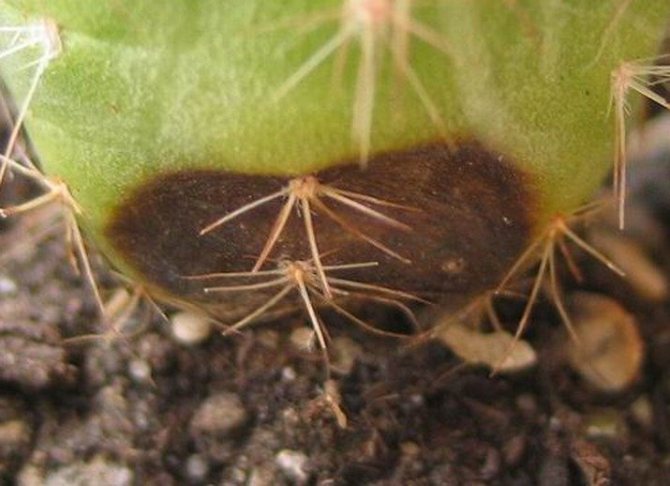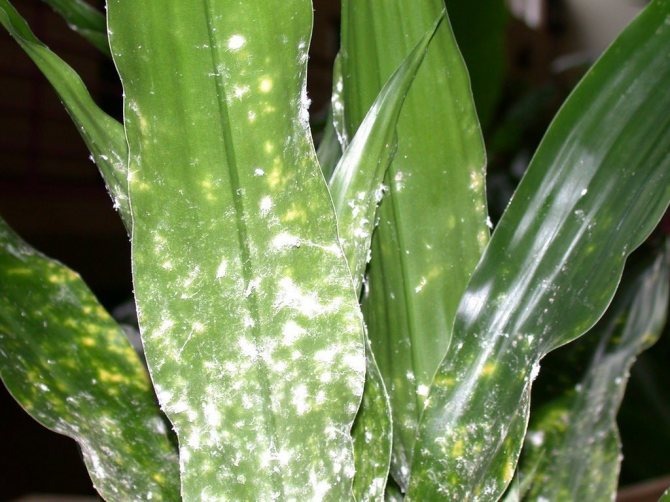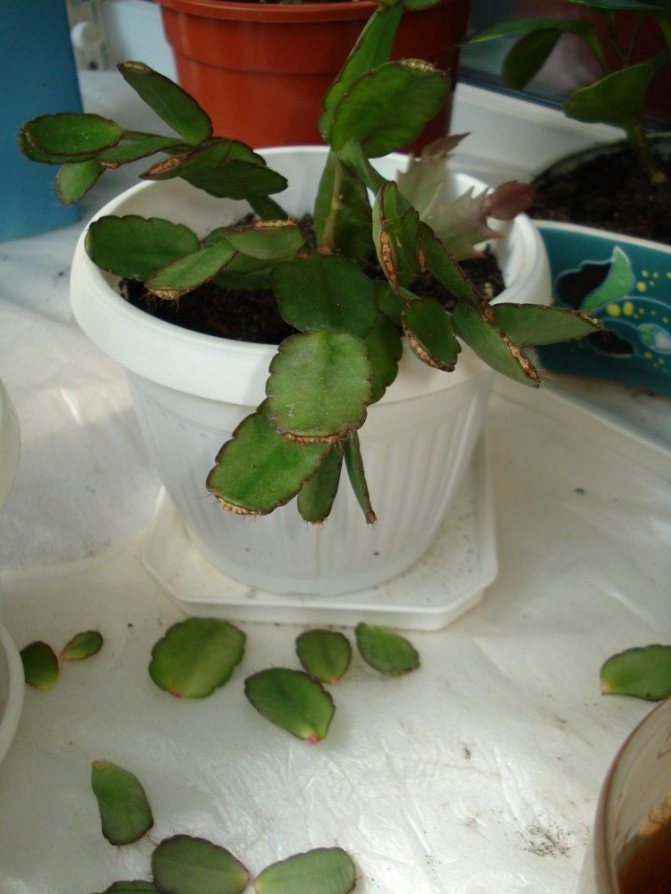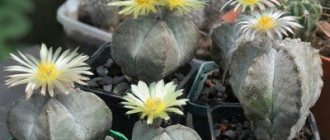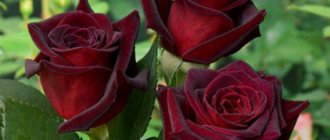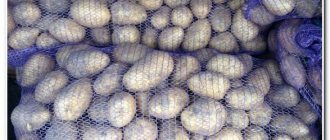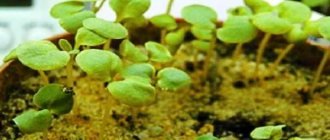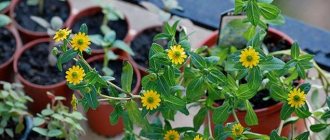Rhipsalidopsis (Rhipsalidopsis) is a not very large epiphytic evergreen shrub and is directly related to the cactaceae family (Cactaceae). In nature, it can be found in the tropical rainforests of South America.
Consisting of ribbed or flat segment segments that reach 4 to 6 centimeters in length and 3 centimeters in width, the shoots are branching and are colored light green. However, when exposed to bright sunlight, the stems sometimes acquire a reddish tint. The edges of the segments have smooth and almost invisible ridges. However, there are spines at the ends of the segments that look like thick bristles. At the tips of the segments, flowers are formed that open wide (up to 4 centimeters in diameter). 1-3 flowers emerge from the 1st areola. In different varieties, flowers can be colored in different ways, for example, these are all color shades from pink to white, as well as to dark red. When the plant fades, rather soft berries-fruits appear on it.
This plant has clear external resemblances to the Schlumberger. But there are a few differences:
- in the structure of the segments - ripsalidopsis has smoothed protrusions along the edges, and Schlumberger - segments, along the edges of which there are sharp teeth;
- in the form of flowers - the flowers of Ripsalidopsis have an even corolla, and they are radially symmetrical, while Schlumberger's corollas are beveled;
- in bloom - Schlumberger blooms in winter and Ripsalidopsis in spring.
Description
Ripsalidopsis stems are very similar to thin, slightly ribbed green leaf-plates, four to six by three cm in size, connected to each other. Flowers of about 4 cm in diameter appear on their tips.
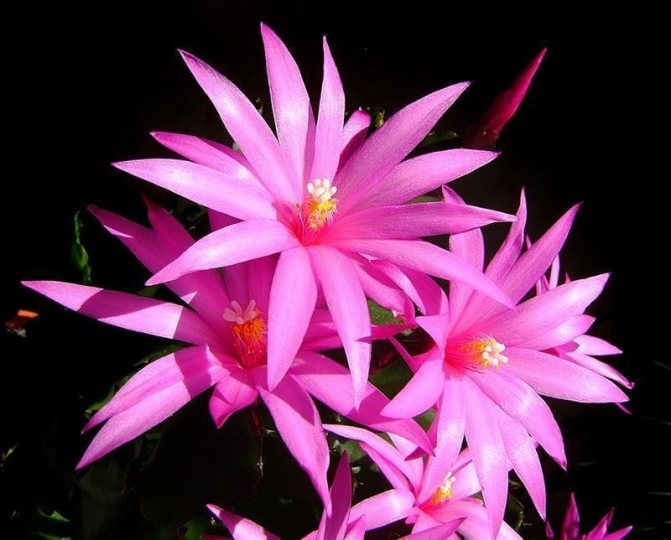
In many cases, waiting for them to appear is the easiest way to determine if Ripsalidopsis or Decembrist is growing on the windowsill.
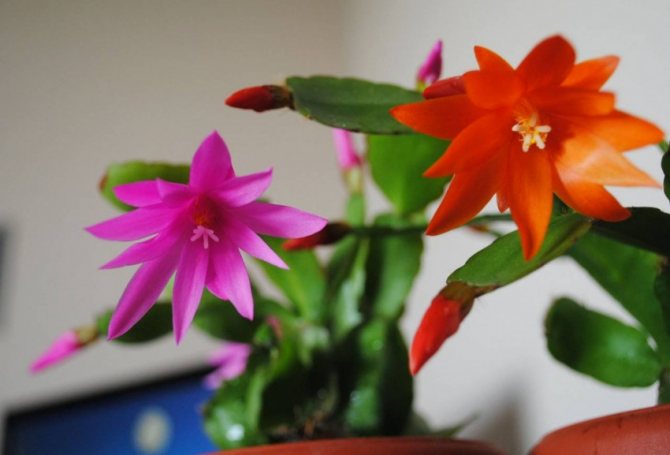

In the first, the buds bloom in the spring, for which it is even called the Easter cactus. In the Decembrist - from November to January, much smaller and with more petals bent outward. Viewing photos of ripsalidopsis will help you learn how to distinguish them and inspire you to purchase such a handsome man.
Views
This unusual flower came to us from the tropical rainforests of Brazil. It should be noted that the Schlumberger is a cactus that has only adapted to dampness and heavy rains. He survived in such conditions due to the fact that he became an epiphyte - that is, he learned to live on other plants. At the same time, the flower is not a parasite - it does not "eat" its owner, but simply peacefully coexists with it.
Schlumberger truncated (Schlumbergera truncatus)
In this species, the shoots can reach 40 cm in length, the stems hang down beautifully. Stem color - light green sometimes can be with a reddish tint, the size of one stem fragment is from 4-5 cm in length and up to 2-2.5 cm in width. There are sharp teeth on the sides of the segments. Flowers of this variety have a variety of shades: from white and pink to purple and lilac.
Schlumberger Buckley (Schlumbergera bucklei) Buckley
Also an ampelous type of plant, the segments of its stem have rounded teeth. Flowers appear at the ends of the stems. The color of the flowers is pinkish lilac.
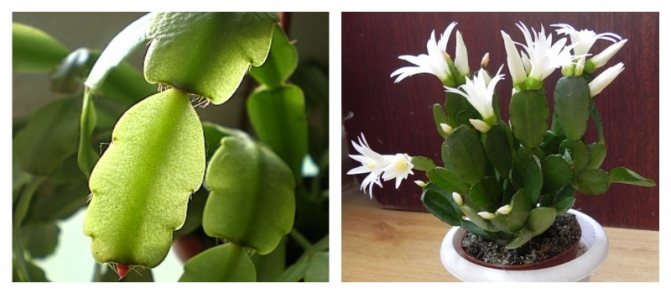

Schlumberger Buckley
Difference between Truncated Schlumberger and Buckle


Schlumberger opuntia (Schlumbergera opuntioides)
This species is more reminiscent of a cactus - the segments of the stem are tear-shaped and covered with spines growing in numerous areoles. In addition, the stem fragments are much thicker than those of other zygocactus species. This species blooms with pinkish-purple flowers in March-April.
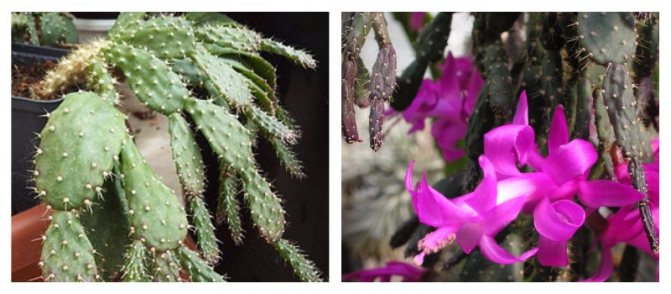

Schlumberger's opuntia
Schlumberger gaertner (Schlumbergera gaertneri)
Stem segments of this species can reach a length of 6-7 cm. Flowers are orange-red, with pointed petals.
Schlumberger Russelian (Schlumbergera Russelliana)
Stems of this species can reach 1 meter in length. Stems are bright green, with red veins, shiny, fleshy. The leaves are rounded. It blooms with red-violet and pink flowers.
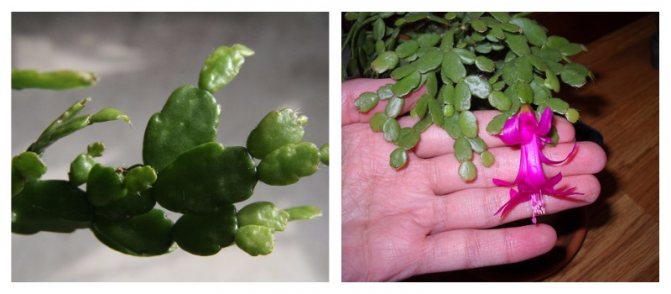

Schlumberger Russelian
Planting and growing an Easter cactus
The plant feels good in loose, light soil - a mixture for growing cactus and succulents is also suitable. It is best to position the pot out of direct sunlight, however a large amount of reflected or diffused light is needed.
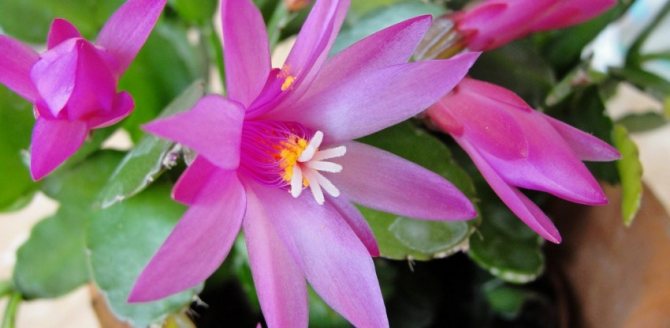

It is recommended to water abundantly once every 2-3 days, but to prevent the cactus from rotting from stagnant water, pour water from the pan half an hour after each watering.
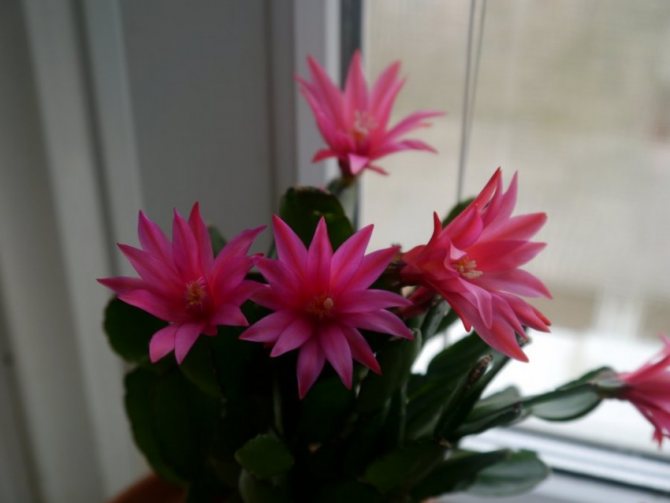

The optimum air temperature in autumn and winter is 10-12 C, during the period of active growth and flowering - 18-23 C, but not higher, the flower does not tolerate heat well.
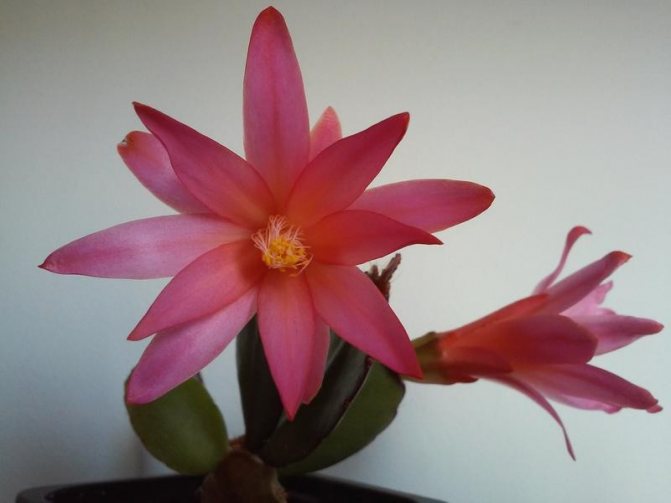

If you do not observe the temperature regime and constantly move the pots, it will not work to make the ripsalidopsis bloom, it is desirable to fertilize, starting at the end of winter and during the growing season. But remember that organic fertilizers are contraindicated - add mineral fertilizers instead.
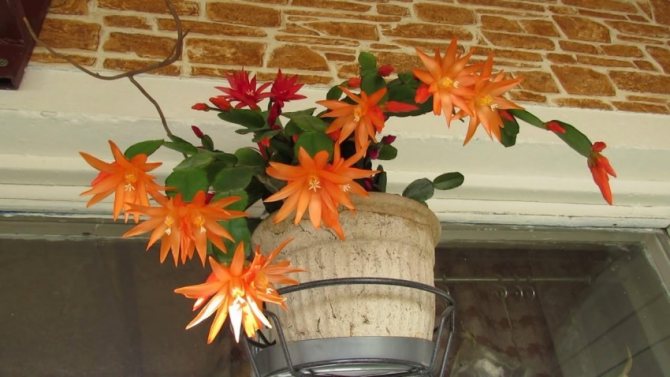

In the process of growth, the "twigs" of the cactus gradually nip and begin to outweigh, which makes it possible to breed flowering Ripsalidopsis in hanging pots-pots.
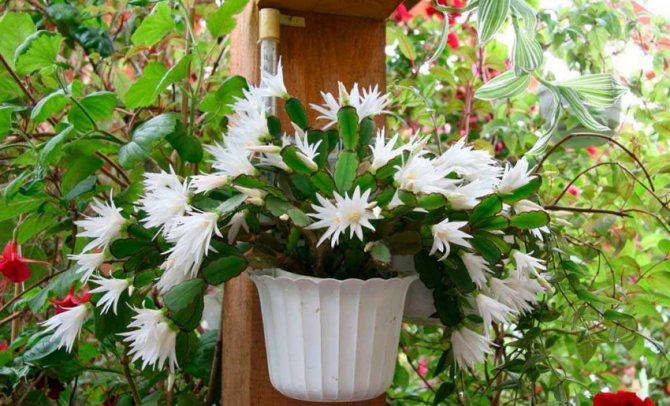

When choosing a container for planting, we recommend choosing wide, but narrow flowerpots due to the fact that the root system of the cactus is poorly developed.
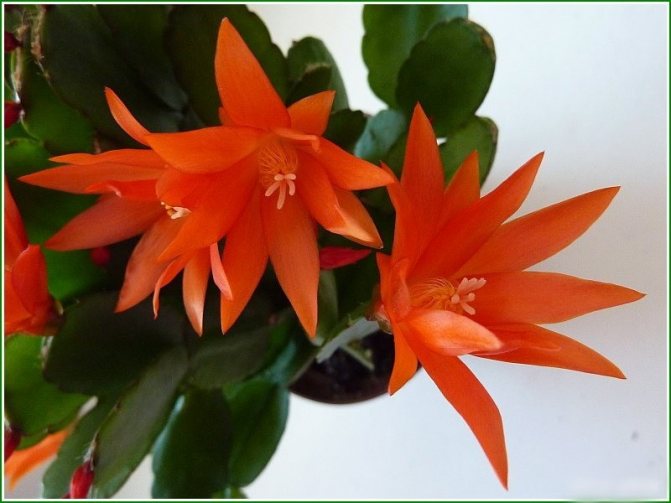

In the home environment, only 2 types of spring cactus are grown - Gartner's Ripsalidopsis and Pink Ripsalidopsis, which are divided into several varieties.
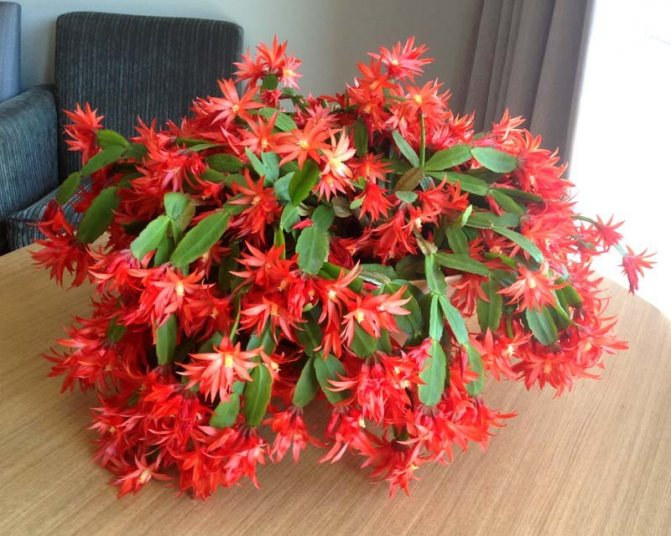

What it is?
Rhipsalidopsis is a plant from the Cactaceae family, the name of which literally translates as "whip-like berry cactus". The people also often use the names Easter Egg, Easter Cactus or Forest Cactus. Sometimes Ripsalidopsis is confused with Schlumberger, but, in fact, they are completely different members of the family. But it is very easy to distinguish it from an ordinary cactus, because the characteristic features of the plant are the absence of thorns and dense skin.
In nature, zygocactus develops not on the ground, but on trees, including sick or old ones. A different plant in this sense is only a support contributing to a better and more efficient development of the root system. The cactus accumulates moisture and useful elements in unusual thickened stems, which are divided into wide leaf-shaped plates. Throughout the growth process, some of them are outweighed over the edge of the container.
The cactus flower grows at the ends of the shoot either in March or April, depending on the variety of the plant.
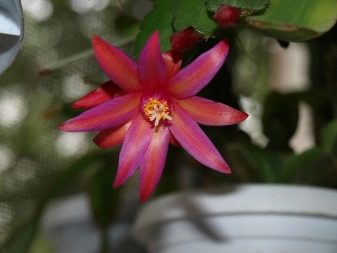

Although the flowering process itself lasts up to two months, the lifespan of an individual inflorescence is no more than a couple of days. The diameter of the opened bud varies from 5 to 8 centimeters, and from 1 to 3 specimens are formed on each shoot. The petals of the flower are very neat and narrowed, with a sharp tip, which makes the opened flower look like a beautiful star. They can be painted in scarlet, burgundy or white. Although the color palette is not very wide, each shade looks very rich and tasty.
The height of the bush reaches 30 centimeters, moreover, it is characterized by sufficient branching. Some stems are 5 centimeters long and can be up to 3 centimeters wide. Usually, a cactus is painted in a light salad shade, but after being exposed to prolonged exposure to sunlight, it can change its color to a variety of red. The top of the ripsalidopsis is crowned with a collection of axillary buds, from which a bunch of whitish bristles grow. After the cactus has finished flowering, the buds are replaced by soft fruits, painted in a pale red hue and resembling a pentahedron.
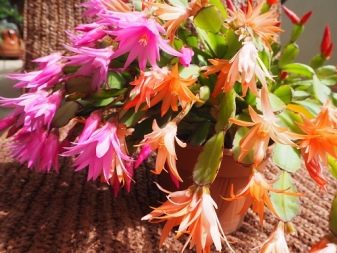

Schlumberger - one of those few plants that have long been lovingly grown on the windowsills of city high-rises, and village houses, and respectable cottages. Back in those days, when the choice of indoor flowers was not as diverse as it is now, this plant delighted the eye with bright flowering at the very beginning of the winter cold.
Many buds invariably appeared on it at the end of autumn, in order to bloom in December with a New Year's fireworks from many beautiful lilac-purple and pink inflorescences. Therefore, everyone knew him by the name Decembrist or barbarian color (Barbarian scythe), because on December 19, at the very peak of the Schlumberger bloom, Barbarian day was celebrated according to the Orthodox calendar. This wonderful plant can also be found under the name Christmas cactus or Christmas tree.
| How to provide proper home care for a Schlumberger. First of all, this means: what to do to Schlumbergera bloomed profusely? |
Content
Where are you from, Schlumberger Rhipsalidopsis and Schlumberger, or does the Decembrist bloom in spring? Possible inaccuracies in care Segments blush A lot of sluggish and wrinkled leaves have appeared All buds have fallen Decembrist does not bloom Decembrist is ill
Where are you from, Schlumberger
Let's start with the origin of the Decembrist. Where did it come to us, is this unusual plant blooming in spite of the season?
Schlumberger (in Latin - Schlumbergera) belongs to the genus of epiphytic forest cacti, whose homeland is southeast Brazil, mountain rainforests. Synonyms are also such names of the Decembrist as Zygocactus and Zygocereus.
For some it may seem strange why in the rainy tropics suddenly grow cacti? At an altitude of 600-1500m above sea level, they settle in the form of compact bushes in cracks in the bark, among the trunks of numerous vines and grow tightly into them, feeding on decaying organic matter.
Broken off pieces of segments quickly form aerial roots and, catching them on the support, give rise to new specimens. Warm tropical rains periodically moisten them for a short time, flowing down, and most of the time the plants live in fairly dry conditions under the canopy of a dense forest.
The flowering of Schlumbergera at home looks simply enchanting and occurs in late spring - early summer. It's strange and why does the Decembrist bloom in winter??
Yes, simply because its habitat is in the southern hemisphere, the Brazilian summer falls on our winter. Plants have genetic memory and, despite the change in geographical latitudes, continue to live according to the cycle established by nature. We have snow and cold, and in the homeland of the Decembrist a blessed summer is coming ...
Rhipsalidopsis and Schlumberger or does the Decembrist bloom in spring
Sometimes the owners of the Decembrist claim that their pet blooms in March-April, showing photographs as evidence. If you look closely at the plant in the image, then most often it turns out that instead of Schlumberger, another epiphytic cactus, Ripsalidopsis, outwardly very reminiscent of a Decembrist, has dissolved its bright red flowers in a pot. It is also called the Easter star, since it is in April that the peak of its bloom is observed.
Although among the Decembrists now you can find more than one variety. As a rule, on our windowsills they bloom:
- schlumberger truncated (truncatus) and
- another hybrid is the Schlumberger bucklei or bucklei.
Take a look at the photo, it is noticeable that the plants differ in the shape of the stem segments. In Ripsalidopsis, their edges are smoothed and rounded, in S. buckley - more pronounced, and in S. truncated - sharply serrated.
And in this photo, we note the difference not only in the appearance of the segments, but also in the structure of the flower.
On the left - Ripsalidopsis, in the center - Sh. Truncated, on the right - Sh. Bouclei.
If in both species of Schlumberger there is a bilateral symmetry of the flower, it is slightly truncated, then in Ripsalidopsis the inflorescence is radially symmetric and looks like a pointed star.
Summarizing what has been said, we can draw the following conclusion: in November-January, Schlumberger bouclei (the so-called "grandmother's Decembrist") blooms, in December-February she passes the baton to Schlumberger truncated, and in the spring we admire the flowering of Ripsalidopsis.
| Rhipsalidopsis |
Someone will object: how to evaluate the flowering of zygocactus, which we observe in garden centers throughout the year, including at the height of summer? It's very simple: it is the result of modern greenhouse equipment, where you can create any conditions for forcing and lush flowering at the right time of the year.
Home care for a Schlumberger
How to create optimal conditions for the growth of the Decembrist?
Usually, for the well-being of the plant and its lush flowering, they seek to create the most favorable conditions close to natural. What are the requirements of a forest cactus?
Lighting
What kind of lighting does a cactus need? Full sun, - many will answer with confidence. With regard to Schlumberger, this answer is not correct. Forest cacti in nature grow in shade, under the canopy of evergreen forests. For the Decembrist, the optimal lighting is the northern and western windowsill, and the east and south - only with a shade of a light tulle curtain.
Does the Decembrist need additional lighting, does it bloom in winter? No, because in order to lay flower buds, the plant must go through a cycle of a gradual decrease in solar activity and a decrease in daylight hours.
It is these factors, coupled with a decrease in air temperature, that lead to the fact that the zygocactus begins to prepare for flowering.
| After the buds have appeared on the bush, the plants are desirable do not touch or unfoldas it is very sensitive to light orientation. The Decembrist can respond to any stress with a sharp drop of flowers, and this phenomenon is very familiar to lovers of epiphytic cacti. |
The soil
Schlumberger will develop well only in a very loose substrate, without the slightest stagnation of water. Remember, in nature, epiphytes do not live in the soil, but on trees and between stones, where moisture practically does not accumulate. Since decaying mosses and bark have a slightly acidic reaction (pH 5.5-6.5), it is advisable to maintain the same in the pot.
How to formulate a suitable substrate? Sod land (leaf compost) is mixed with sand and high moor sour peat in a ratio of 1: 1: 1. Instead of sand, you can add vermiculite for looseness, and pieces of moss to maintain moisture. A drainage layer at the bottom of the pot is required - about a third of the total height.
Transfer
They are transplanted to the Schlumberger in the spring every 1-2 years, and the new pot should be only slightly (2-3 cm in diameter and height) larger. If you provide the Decembrist with a disproportionately large container, then you can forget about flowering it for two years, until the entire land lump is mastered by the roots.
Watering
Watering - as it dries. It is categorically impossible to allow the roots to dry completely, but keeping them constantly moist is also not worth it. From the end of summer, watering is gradually reduced, which contributes to the beginning of the laying of flower buds.
Top dressing
Fertilize Schlumberger throughout the season with various mineral fertilizers, depending on the phase of development. During the period of active growth from spring to autumn with complex fertilization without a predominant nitrogen component.During the flowering period (November to January), the plant needs feeding for flowering plants.
Breeding Schlumberger
There is nothing easier - the unscrewed segments are slightly dried (several hours) and deepened for rooting by 1 cm in loose soil.
Schlumberger cuttings take root very easily and quickly.
How to achieve lush bloom Schlumberger
For a Schlumberger bloom to be truly fabulous, you need to take into account its natural characteristics.
The general care of the Decembrist directly depends on the phase of the natural cycle that the plant is going through at the moment. Schlubmberger has four periods of development:
- vegetation (March - September);
- dormant period (September - November);
- flowering (November-January);
- the second period of rest (February - March).
Leaving from March to September
The period of rapid growth begins at the zygocactus in the spring, it builds up segments and responds well to feeding with complex fertilizers. Top dressing is selected with a minimum nitrogen content in order to avoid root rot.
If you take it out for the summer "for a walk" in the garden, then the Decembrist will really like it. However, you need to allocate a place in the diffused shade and do not forget to water the bush.
Leaving from September to November
From September, the plant begins to prepare for flowering and lays flower buds (however, outwardly this happens unnoticed by the observer). Perhaps this period is the most responsible for the grower. If you make a mistake, you will lose the flowering of a spectacular plant.
As already noted, during this period, watering is reduced, the air temperature is lowered. However, you don't have to do this on purpose, because it gets chilly outside. Do not take the Decembrist pot out of the garden or balcony until there is a threat of frost. A decrease in temperature to +3 C is not critical for the plant, on the contrary, it stimulates the laying of buds.
The optimal place of detention during the rest period is an unheated loggia, where the Decembrist can stay until November. Watering is rare. Usually, after such a shake-up, the flowering of Schlumberger is very abundant and long-lasting.
Leaving from November to January
In early November, the plant is brought into the room, and soon it is covered with buds. At this time, the bush is watered with fertilizers for flowering (with a high content of phosphorus and potassium), as well as 1-2 times with a solution of calcium nitrate.
Leaving from February to March
After flowering, the plant is formed for the splendor of the bush and more abundant flowering afterwards. To do this, unscrew (unscrew, not cut off, and do not cut off) some segments. Soon, new shoots will grow here, on which buds will bloom.
Possible care errors
Here are some of the most common problems that arise when caring for a Schlumberger.
- Segments blush
The cactus stood in the cold. Redness is a defensive reaction to hypothermia. Move the plant to a warm place and it will soon turn green again.
- A lot of flaccid and wrinkled leaves appeared
The reasons can be exactly the opposite: underfilling and overflowing. It is as easy as shelling pears to deal with underfilling - spill the pot well and spray the Schlumberger with warm water.
But it is more difficult to deal with excessive watering. The roots of the plant are examined; they, as a rule, are rotten. Again, this is quite fixable - the roots are unscrewed and the bush is re-rooted again in fresh loose soil.
- All the buds fell
This phenomenon is associated with stress: they changed the location of the pot, forgot to water the Decembrist on time, made a draft for the plant.
- Decembrist does not bloom
There are many reasons, it is worth revising the watering regime, shading, or, conversely, moving the pot towards the light. In addition, if the Schlumberger grows in a cramped pot, it is necessary to transplant it into a suitable soil in terms of volume.
But the main reason for failures is ignoring the dormant period, keeping the plant in "warmth and bliss" at this moment.
Decembrist fell ill
Schlumberger rarely gets sick.Basically, it can be affected by fungal infections - fusarium and late blight. In this case, the segments fall off, and the remaining ones have a pale color of the leaf. In this case, the plant is sprayed with Skor or Topaz preparations, the soil is spilled with a solution of Vitaros or Maxim.
With a bacterial infection, when the root collar becomes soft and slippery to the touch, fungicides most likely will not help. You can save the plant by re-rooting cuttings from the apical shoots. Previously, the segments should be “bathed” in a pink solution of potassium permanganate or the pharmaceutical antibacterial drug Trichopol (2 tablets per glass of water).
Photo credits: Nadezhda Nesterova, BestPhotoStudio, Ivan Stupa, Sergey Kurov, Oksana Alyoshina.
Read also:
Why doesn't the Decembrist bloom?
Schlumberger (Decembrist) - basic rules of care
Ripsalis features
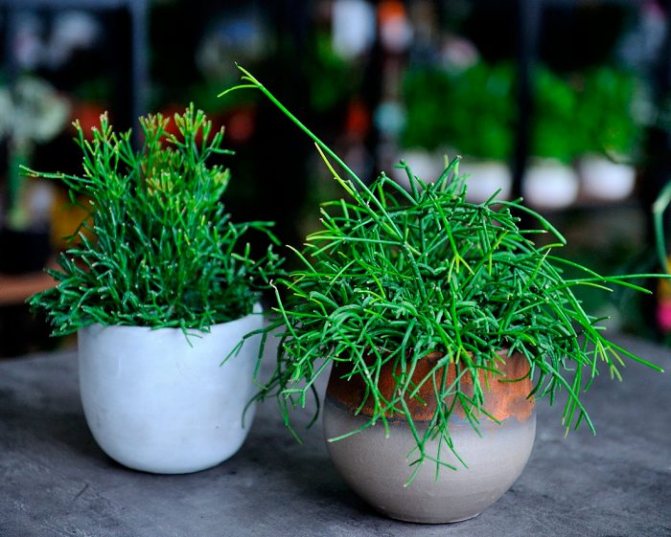

Rhipsalis is an epiphytic shrub with strong branching and aerial roots. All representatives of this genus have pubescence on the surface of the aboveground parts, and none of the species have spines. Leafy drooping, articulated shoots in cross-section can be rounded, ribbed or flat. Areoles are placed on the surface of the shoots. Actinomorphic small flowers have a corolla that can be yellow, pinkish, white and orange. Flowers are placed either at the top of the stem or along its entire length. Ripsalis produces berry-like juicy fruits the size of a gooseberry, and they can be colored black, white or pink.
Transfer
At the bottom of the container, two layers of about 3 cm are laid: drainage (for example, from expanded clay) and a soil mixture. Moisten the resulting filling. Extracting an Easter cactus and cleaning its roots without rinsing - waterlogging is never good for Ripsalidopsis. Cut off even slightly rotten roots with sharp, disinfected scissors.
- Katarantus: planting instructions, care features and growing in the garden (90 photos)


Violets - rules of care and interior decoration with a blooming decoration (105 photo ideas)
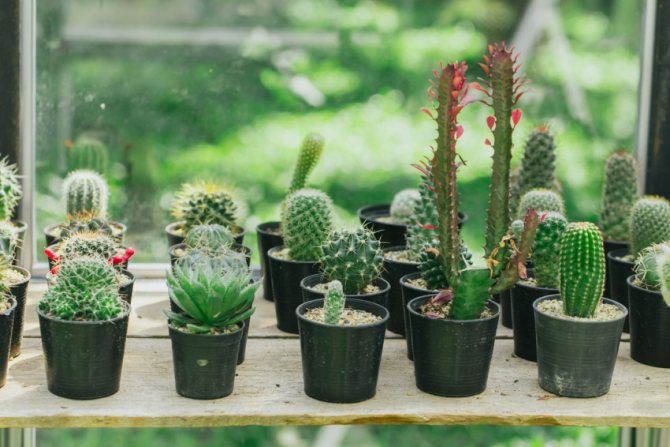

Cactus - popular types of home cactus and the rules for composing a composition from succulents
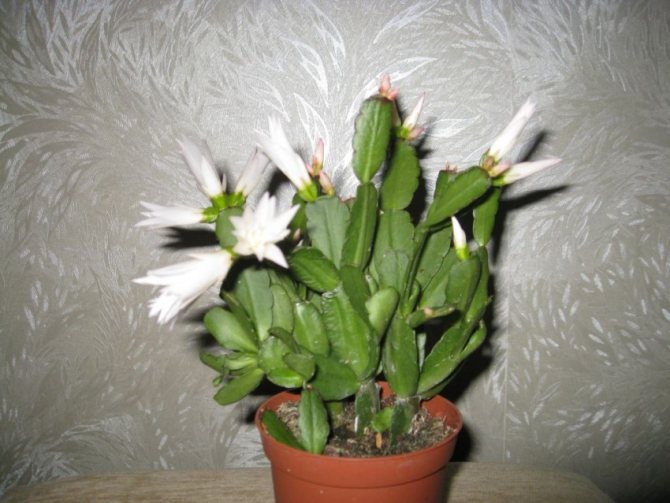

Move to a pot and top up the soil, pressing down slightly at the base of the stems. Next, gently pull the tips of the shoots so that the flower, rising from the ground, takes the optimal position.
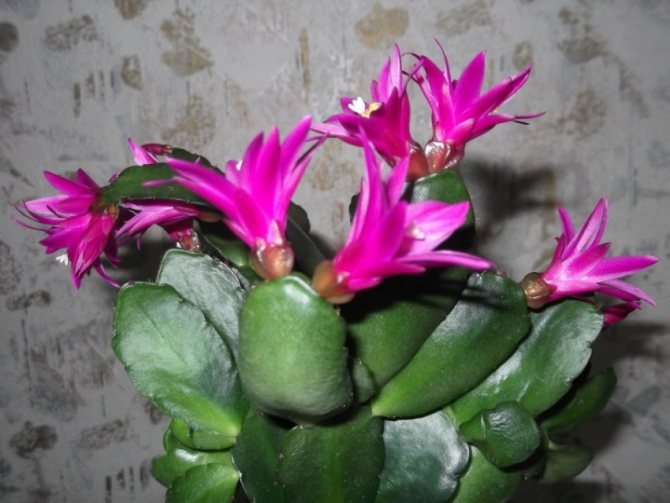

Water the Ripsalidopsis again and store in a shaded area for about a week. During this period of time, it is better not to touch or water it.
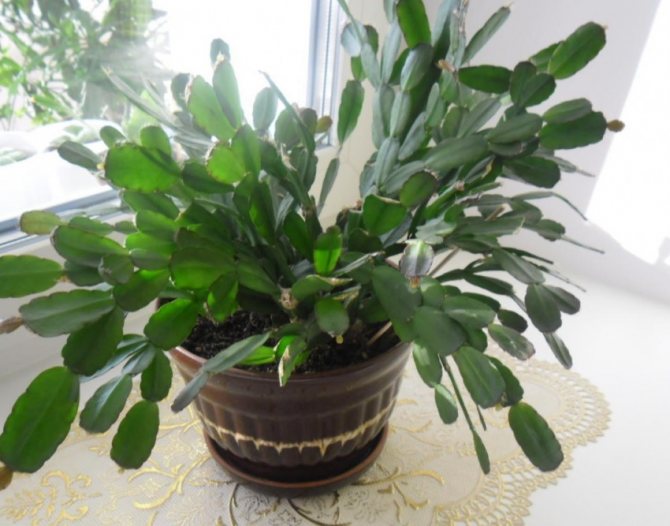

After the expiration of the period, put the flowerpot in the same place or choose the most suitable place in accordance with the tips given earlier.
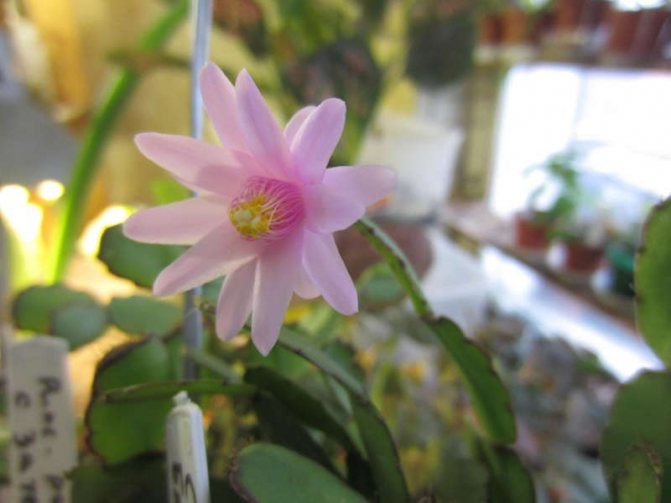

Following the recommendations on how to care for Ripsalidopsis at home is not as difficult as it seems to an untrained gardener, because all efforts will pay off with a riot of colors on your window!
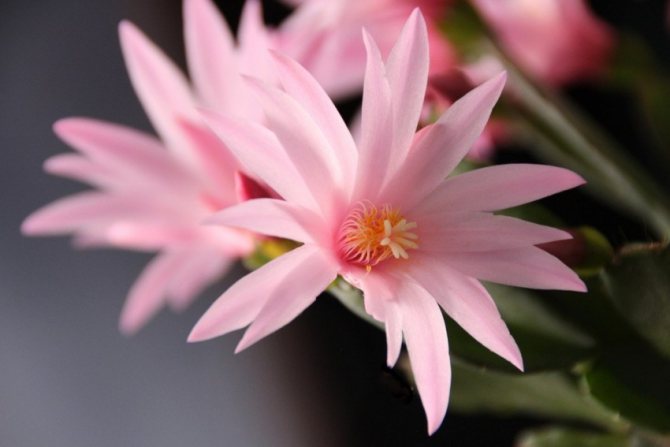

Pruning
During the transplant of Ripsalidopsis, pruning of old branches is carried out
It is important to do this during the dormant period, until young buds begin to form. Flowering will not start if the shrub is cut in early spring
This procedure is only necessary in winter. It stimulates the growth of new branches. Usually, in place of 1 cut off stem, 3-4 new ones appear, which in a year will tie large buds. Pruning helps to form the correct crown of the flower, it rejuvenates and heals it. Lignified shoots are cut off with pruners or scissors, and young damaged segments are easily broken off by hand. They can be used for breeding.
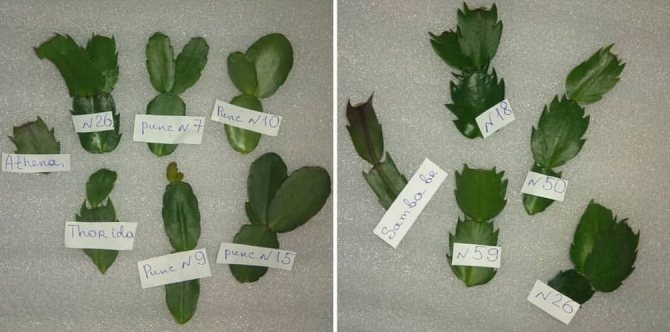

Young segments of Ripsalidopsis ready for rooting
Difference from Schlumberger
Rhipsalidopsis has a double. This is a Schlumberger or zygocactus, popularly a Decembrist. You can distinguish between these plants by some features.
| Rhipsalidopsis | Schlumberger | |
| Segments | The protrusions are smoothed and invisible | Sharp barbed protrusions |
| Flower | Radial symmetry, smooth corolla | Corollas are clearly beveled |
| Flowering period | Spring | Winter |
You can read more about the differences between Ripsalidopsis and Schlumberger here.
Similar plants
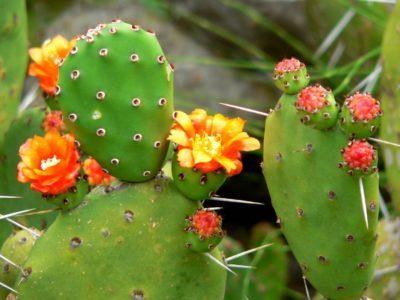

Flowers similar to Ripsalidopsis are included in the subspecies forest cacti. They all have fleshy stems, a similar structure and require the same conditions. Among the similar ones is the epiphyllum. It has a leaf-shaped stem of dark green color. Flowers reach 12 cm in diameter, bright colors, fragrant aroma. What other flowers are similar?
- Rhipsalis... It is a dense shrub that has many slender stems. At the ends of the shoots, small buds of yellow shades.
- Prickly pear... The segments are thick and flat to form one trunk. It has an abundance of thorns. Also on the main stem there are shoots and flowers of various shades.
- Pereskia... Ancient succulent plant. The leaves are decorative, all the functions are performed by the stem. The fruits are edible.
- Scaly cactus... It has elongated stems, buds are formed at the edges. Bright flowers and fruits.
So, Ripsalidopsis is a great option for growing at home. Long stems will look good in a hanging planter, and bright flowers will delight the eye and fill the room with a pleasant aroma.

